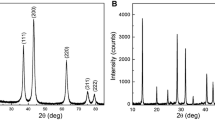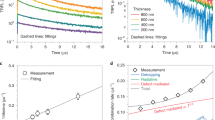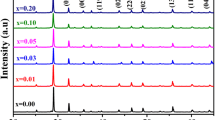Abstract
Narrow-bandgap tin-lead (Sn-Pb) mixed perovskite solar cells (PSCs) play a key role in constructing perovskite tandem solar cells that are potential to overpass Shockley-Queisser limit. A robust, chemically stable and lowtemperature-processed hole transporting layer (HTL) is essential for building high-efficiency Sn-Pb solar cells and perovskite tandem solar cells. Here, we explore a roomtemperature-processed NiOx (L-NiOx) HTL based on nanocrystals (NCs) for Sn-Pb PSCs. In comparison with hightemperature-annealed NiOx (H-NiOx) film, the L-NiOx film shows deeper valence band and lower trap density, which increases the built-in potential and reduces carrier recombination, leading to a power conversion efficiency of 18.77%, the record for NiOx-based narrow-bandgap PSCs. Furthermore, the device maintains about 96% of its original efficiency after 50 days. This work provides a robust and room-temperatureprocessed HTL for highly efficient and stable narrow-bandgap PSCs.
摘要
钙钛矿叠层太阳能因为具有超过肖克利-奎伊瑟效率极限的潜力而备受关注. 窄带隙锡-铅(Sn-Pb)共混钙钛矿太阳能电池(PSCs)在钙钛矿叠层太阳能电池的构建中起着关键作用. 制备稳定性好、可低温处理的空穴输送层是构建高效Sn-Pb钙钛矿太阳能电池和钙钛矿叠层太阳能电池的关键. 在此, 我们开发了一种室温处理的纳米晶体氧化镍(L-NiOx)作为空穴传输层用于Sn-Pb共混钙钛矿太阳能电池结构. 相比于高温烧结的氧化镍(H-NiOx)薄膜,L-NiOx表现出较深的价带和较低的陷阱密度, 这增大了内建电势和减少了载流子的复合, 使器件的功率转换效率达到了18.77%, 这是基于NiOx空穴传输层的窄带隙Sn-Pb钙钛矿太阳能电池的最高效率. 此外, 该器件的效率在50天后仍能保持原有效率的96%, 具有非常好的稳定性. 这项工作为高效稳定窄带隙PSCs的制备提供了一种可在室温下制备的无机空穴传输材料.
Similar content being viewed by others
References
Lin R, Xiao K, Qin Z, et al. Monolithic all-perovskite tandem solar cells with 24.8% efficiency exploiting comproportionation to sup press Sn(II) oxidation in precursor ink. Nat Energy, 2019, 4: 864–873
Kapil G, Ripolles TS, Hamada K, et al. Highly efficient 17.6% tinlead mixed perovskite solar cells realized through spike structure. Nano Lett, 2018, 18: 3600–3607
Xu G, Bi P, Wang S, et al. Integrating ultrathin bulk-heterojunction organic semiconductor intermediary for high-performance low-bandgap perovskite solar cells with low energy loss. Adv Funct Mater, 2018, 28: 1804427
Zhu Z, Li N, Zhao D, et al. Improved efficiency and stability of Pb/Sn binary perovskite solar cells fabricated by galvanic displacement reaction. Adv Energy Mater, 2019, 9: 1802774
Pargoletti E, Hossain UH, Di Bernardo I, et al. Room-temperature photodetectors and VOC sensors based on graphene oxide-ZnO nano-heterojunctions. Nanoscale, 2019, 11: 22932–22945
Wei M, Xiao K, Walters G, et al. Combining efficiency and stability in mixed tin-lead perovskite solar cells by capping grains with an ultrathin 2D layer. Adv Mater, 2020, 32: 1907058
Gu S, Lin R, Han Q, et al. Tin and mixed lead-tin halide perovskite solar cells: Progress and their application in tandem solar cells. Adv Mater, 2020, 1907392
Tong J, Song Z, Kim DH, et al. Carrier lifetimes of >1 μs in Sn-Pb perovskites enable efficient all-perovskite tandem solar cells. Science, 2019, 364: 475–479
You J, Meng L, Song TB, et al. Improved air stability of perovskite solar cells via solution-processed metal oxide transport layers. Nat Nanotech, 2016, 11: 75–81
Liu Z, Chang J, Lin Z, et al. High-performance planar perovskite solar cells using low temperature, solution-combustion-based nickel oxide hole transporting layer with efficiency exceeding 20%. Adv Energy Mater, 2018, 8: 1703432
Ye L, Fan B, Zhang S, et al. Perovskite-polymer hybrid solar cells with near-infrared external quantum efficiency over 40%. Sci China Mater, 2015, 58: 953–960
Park JH, Seo J, Park S, et al. Efficient CH3NH3PbI3 perovskite solar cells employing nanostructured p-type NiO electrode formed by a pulsed laser deposition. Adv Mater, 2015, 27: 4013–4019
Wang H, Yu Z, Jiang X, et al. Efficient and stable inverted planar perovskite solar cells employing CuI as hole-transporting layer prepared by solid-gas transformation. Energy Technol, 2017, 5: 1836–1843
Ye S, Sun W, Li Y, et al. CuSCN-based inverted planar perovskite solar cell with an average PCE of 15.6%. Nano Lett, 2015, 15: 3723–3728
Zuo C, Ding L. Solution-processed Cu2O and CuO as hole transport materials for efficient perovskite solar cells. Small, 2015, 11: 5528–5532
Schulz P, Tiepelt JO, Christians JA, et al. High-work-function molybdenum oxide hole extraction contacts in hybrid organicinorganic perovskite solar cells. ACS Appl Mater Interfaces, 2016, 8: 31491–31499
Zhao K, Munir R, Yan B, et al. Solution-processed inorganic copper(i) thiocyanate (CuSCN) hole transporting layers for efficient p-i-n perovskite solar cells. J Mater Chem A, 2015, 3: 20554–20559
Arora N, Dar MI, Hinderhofer A, et al. Perovskite solar cells with CuSCN hole extraction layers yield stabilized efficiencies greater than 20%. Science, 2017, 358: 768–771
Chatterjee S, Pal AJ. Introducing Cu2O thin films as a holetransport layer in efficient planar perovskite solar cell structures. J Phys Chem C, 2016, 120: 1428–1437
Yu W, Li F, Wang H, et al. Ultrathin Cu2O as an efficient inorganic hole transporting material for perovskite solar cells. Nanoscale, 2016, 8: 6173–6179
Cao J, Wu B, Peng J, et al. Copper-copper iodide hybrid nanostructure as hole transport material for efficient and stable inverted perovskite solar cells. Sci China Chem, 2019, 62: 363–369
Qin P, He Q, Ouyang D, et al. Transition metal oxides as holetransporting materials in organic semiconductor and hybrid perovskite based solar cells. Sci China Chem, 2017, 60: 472–489
Yu D, Hu Y, Shi J, et al. Stability improvement under high efficiency— Next stage development of perovskite solar cells. Sci China Chem, 2019, 62: 684–707
Chen H, Wei Q, Saidaminov MI, et al. Efficient and stable inverted perovskite solar cells incorporating secondary amines. Adv Mater, 2019, 31: 1903559
Yang Z, Rajagopal A, Chueh CC, et al. Stable low-bandgap Pb-Sn binary perovskites for tandem solar cells. Adv Mater, 2016, 28: 8990–8997
Chi D, Huang S, Zhang M, et al. Composition and interface engineering for efficient and thermally stable Pb-Sn mixed lowbandgap perovskite solar cells. Adv Funct Mater, 2018, 28: 1804603
Han Q, Wei Y, Lin R, et al. Low-temperature processed inorganic hole transport layer for efficient and stable mixed Pb-Sn lowbandgap perovskite solar cells. Sci Bull, 2019, 64: 1399–1401
Kresse G, Furthmuller J. Efficient iterative schemes for ab initio total-energy calculations using a plane-wave basis set. Phys Rev B, 1996, 54: 11169–11186
Kresse G, Furthmuller J. Efficiency of ab-initio total energy calculations for metals and semiconductors using a plane-wave basis set. Comput Mater Sci, 1996, 6: 15–50
Blochl PE. Projector augmented-wave method. Phys Rev B, 1994, 50: 17953–17979
Perdew JP, Burke K, Ernzerhof M. Generalized gradient approximation made simple. Phys Rev Lett, 1996, 77: 3865–3868
Dudarev SL, Botton GA, Savrasov SY, et al. Electron-energy-loss spectra and the structural stability of nickel oxide: An LSDA+U study. Phys Rev B, 1998, 57: 1505–1509
Zhang WB, Yu N, Yu WY, et al. Stability and magnetism of vacancy in NiO: A GGA+U study. Eur Phys J B, 2008, 64: 153–158
Chen W, Wu Y, Fan J, et al. Understanding the doping effect on NiO: Toward high-performance inverted perovskite solar cells. Adv Energy Mater, 2018, 8: 1703519
Ani MH, Kamarudin MA, Ramlan AH, et al. A critical review on the contributions of chemical and physical factors toward the nucleation and growth of large-area graphene. J Mater Sci, 2018, 53: 7095–7111
Xia X, Jiang Y, Wan Q, et al. Lithium and silver co-doped nickel oxide hole-transporting layer boosting the efficiency and stability of inverted planar perovskite solar cells. ACS Appl Mater Interfaces, 2018, 10: 44501–44510
Nukunudompanich M, Budiutama G, Suzuki K, et al. Dominant effect of the grain size of the MAPbI3 perovskite controlled by the surface roughness of TiO2 on the performance of perovskite solar cells. CrystEngComm, 2020, 22: 2718–2727
Liu D, Zhou W, Tang H, et al. Supersaturation controlled growth of MAFAPbI3 perovskite film for high efficiency solar cells. Sci China Chem, 2018, 61: 1278–1284
Wetzelaer GJAH, Scheepers M, Sempere AM, et al. Trap-assisted non-radiative recombination in organic-inorganic perovskite solar cells. Adv Mater, 2015, 27: 1837–1841
Chen K, Wu P, Yang W, et al. Low-dimensional perovskite interlayer for highly efficient lead-free formamidinium tin iodide perovskite solar cells. Nano Energy, 2018, 49: 411–418
Chen W, Wu Y, Yue Y, et al. Efficient and stable large-area perovskite solar cells with inorganic charge extraction layers. Science, 2015, 350: 944–948
Tan H, Jain A, Voznyy O, et al. Efficient and stable solutionprocessed planar perovskite solar cells via contact passivation. Science, 2017, 355: 722–726
Jiang Q, Zhang L, Wang H, et al. Enhanced electron extraction using SnO2 for high-efficiency planar-structure HC(NH2)2PbI3-based perovskite solar cells. Nat Energy, 2017, 2: 16177
Lin HW, Lu CW, Lin LY, et al. Pyridine-based electron transporting materials for highly efficient organic solar cells. J Mater Chem A, 2013, 1: 1770–1777
Fabregat-Santiago F, Garcia-Belmonte G, Mora-Seró I, et al. Characterization of nanostructured hybrid and organic solar cells by impedance spectroscopy. Phys Chem Chem Phys, 2011, 13: 9083–9118
Liu C, Wang K, Du P, et al. Efficient solution-processed bulk heterojunction perovskite hybrid solar cells. Adv Energy Mater, 2015, 5: 1402024
Acknowledgements
The authors greatly thank the Instrument Analysis Center and Electron Microscope Center of ShanghaiTech University. This work was supported by the National Key Research and Development Program of China (2016YFA0204000), the National Natural Science Foundation of China (61935016, U1632118 and 21571129), start-up funding from ShanghaiTech University, Young 1000 Talents Program, Science Fund for Creative Research Groups (21421004), and the Center for High-resolution Electron Microscopy (ChEM) at ShanghaiTech University (EM02161943).
Author information
Authors and Affiliations
Contributions
Chen H and Ning Z designed and directed this study; Chen H carried out all the experiments; Peng Z, Xu K, Yu D, Han C and Li H helped material and device characterizations; Wei Q carried out and interpreted the DFT caculations; Ning Z supervised the whole project; Chen H wrote the manuscript and Ning Z revised it. All authors discussed the results and commented on the final manuscript.
Corresponding author
Additional information
Conflict of interest
The authors declare that they have no conflict of interest.
Zijian Peng is currently a master student at the School of Physical Science and Technology, ShanghaiTech University. He received his BS degree in materials chemistry from Sun Yat-sen University in 2013. His curent research interest mainly focuses on highly efficient and stable perovskite solar cells.
Zhijun Ning is an assistant professor at the School of Physical Science and Technology, ShanghaiTech University, China. He received his PhD degree from the Department of Applied Chemistry, East China University of Science and Technology. From 2011 to 2014, he was a Postdoctoral Scholar in the Department of Electrical and Computer Engineering, University of Toronto. His current research interest focuses on solution-processed optoelectronic materials and devices.
Electronic supplementary material
Rights and permissions
About this article
Cite this article
Chen, H., Peng, Z., Xu, K. et al. Band alignment towards high-efficiency NiOx-based Sn-Pb mixed perovskite solar cells. Sci. China Mater. 64, 537–546 (2021). https://doi.org/10.1007/s40843-020-1470-5
Received:
Accepted:
Published:
Issue Date:
DOI: https://doi.org/10.1007/s40843-020-1470-5




